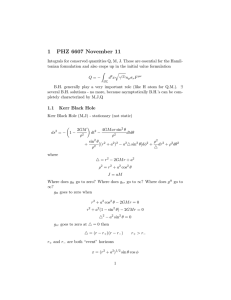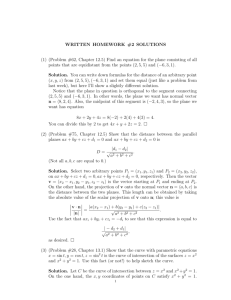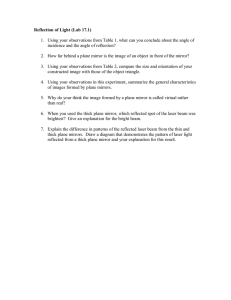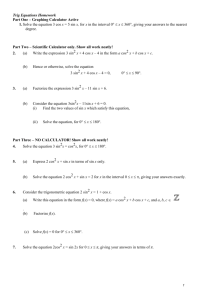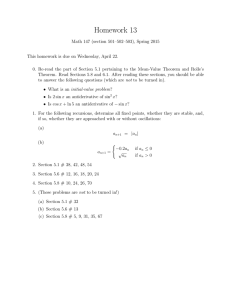Freshman-Sophomore Contest 2007 first-year students
advertisement
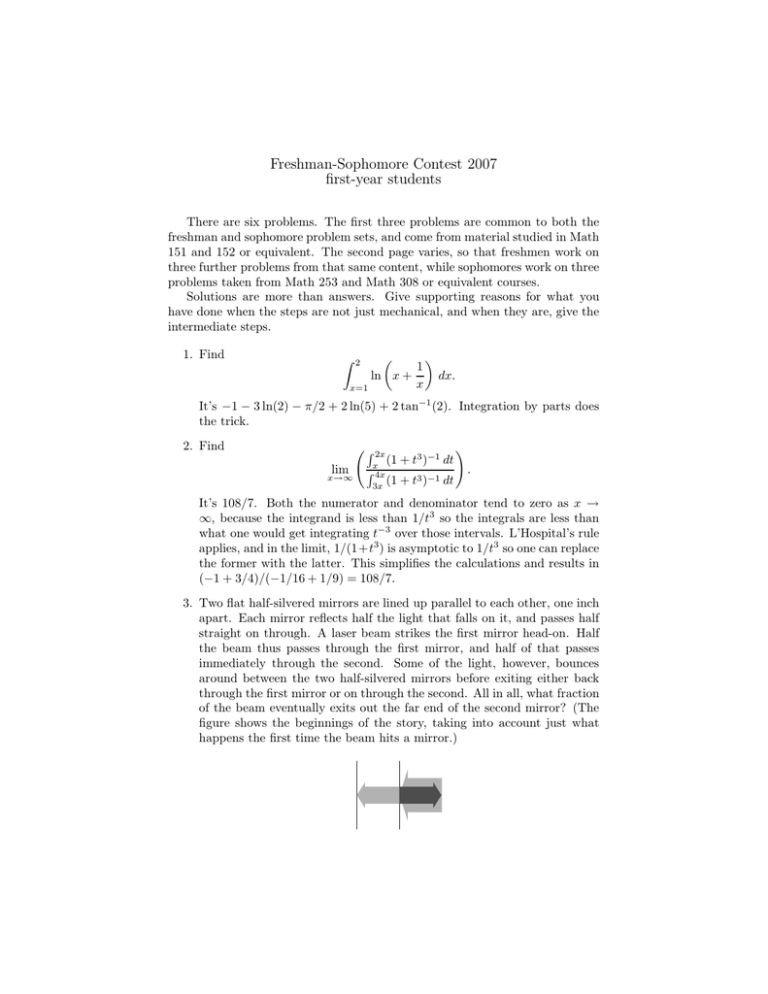
Freshman-Sophomore Contest 2007 first-year students There are six problems. The first three problems are common to both the freshman and sophomore problem sets, and come from material studied in Math 151 and 152 or equivalent. The second page varies, so that freshmen work on three further problems from that same content, while sophomores work on three problems taken from Math 253 and Math 308 or equivalent courses. Solutions are more than answers. Give supporting reasons for what you have done when the steps are not just mechanical, and when they are, give the intermediate steps. 1. Find 2 1 dx. ln x + x x=1 Z It’s −1 − 3 ln(2) − π/2 + 2 ln(5) + 2 tan−1 (2). Integration by parts does the trick. 2. Find lim x→∞ R 2x (1 + t3 )−1 dt Rx4x 3x (1 + t3 )−1 dt ! . It’s 108/7. Both the numerator and denominator tend to zero as x → ∞, because the integrand is less than 1/t3 so the integrals are less than what one would get integrating t−3 over those intervals. L’Hospital’s rule applies, and in the limit, 1/(1+t3 ) is asymptotic to 1/t3 so one can replace the former with the latter. This simplifies the calculations and results in (−1 + 3/4)/(−1/16 + 1/9) = 108/7. 3. Two flat half-silvered mirrors are lined up parallel to each other, one inch apart. Each mirror reflects half the light that falls on it, and passes half straight on through. A laser beam strikes the first mirror head-on. Half the beam thus passes through the first mirror, and half of that passes immediately through the second. Some of the light, however, bounces around between the two half-silvered mirrors before exiting either back through the first mirror or on through the second. All in all, what fraction of the beam eventually exits out the far end of the second mirror? (The figure shows the beginnings of the story, taking into account just what happens the first time the beam hits a mirror.) One third of the light gets through. On the first pass, one quarter gets through, and one quarter bounces back toward the first mirror. Of that, half goes back into the gap, and of that half, half goes through mirror 2 the second time, so half of half of one quarter makes 1 part in 16. Continuing in this fashion, the fraction of the beam that goes out the far end of mirror two on thePfirst, second, third etc. pass is 1/4, 1/16, 1/64, and so on, for ∞ a total of n=1 4−n = 13 . 4. Find the maximum value of the function of two variables given by f (x, y) = sin(x) sin(y) cos(x + y), and find a point (x, y) at which that maximum is reached. The function f is periodic with period 2π in both x and y, and it’s continuous, so a maximum exists and is attained at some point (x0 , y0 ) where ∂f /∂x = 0 and ∂f /∂y = 0. Suppose (x0 , y0 ) is such a point, and one at which the maximum is obtained. Either cos(x + y) is positive, or it is negative. Assume first that it is positive. Then along the line x + y = x0 + y0 = S, sin(x) sin(y) = sin(x) sin(S − x). The correct value of x must be one that maximizes this, and that happens when x = y because, in general, sin2 z ≥ sin(z − a) sin(z + a) = sin2 z cos2 a − sin2 a cos2 z. Now working along the line y = x, we maximize sin2 x cos(2x) by maximizing sin2 x(cos2 x − sin2 x). Setting u = sin2 x, we are trying to maximize u(1 − u) − u2 = u − 2u2 , with the constraint that 0 ≤ u ≤ 1. The overall maximum happens to occur at u = 1/4 (differentiate, or just find the vertex of the parabola), so sin(x) = 1/2 so x = π/6 will serve, and of course with y = x, that gives x = y = π/6, and f (π/6, π/6) = 1/8. (There are many ways to work this. 5. Consider the system of differential equations x′ (t) = −y(t) − 1 ′ y (t) = −x(t) − 2 x(0) = 10 y(0) = 10 Let T be the least positive value of t for which y(T ) = 0. Find x(T ). This can be solved with the formal machinery of systems of differential equations, and eigenvectors and eigenvalues of matrices. But here, there is a shortcut. First, we set u(t) = x(t) + 2 and v(t) = y(t) + 1. This gets rid of the constant terms, so the system becomes u′ = −v, v ′ = −u together with initial conditions u(0) = 12, v(0) = 11. The information in the original system is then equivalent to this one: u′′ (t) = u u(0) = 12 v ′′ (t) = v v(0) = 11 u′ (0) = −11 v ′ (0) = −12 Each of these new differential equations can be solved individually, and the solution for v can be worked with to obtain the value of√t at which v = −1 (so that y = 0). That value of t is t = ln(−1 + 2 6). From here, the solution can be completed. But there is a better way. Note that (u2 − v 2 )′ = −2uv − (−2vu) = 0. Thus u2 − v 2 is√constant. Now √ initially u2 − v 2 = 23, so when v = 1 (so that y = 0), u = 24 and so x = 24 − 2. 6. Consider three unit vectors u, v, and w, none of them lying in the plane through the origin and the other two. In this problem, when working on any part of the problem you may take as given all of the previous parts. (a) Find the equation of the plane Pu,v made up of all points that are the same distance from u as from v. That would be x · (u − v) = 0, in vector notation, or written out, x(u1 − v1 ) + y(u2 − v2 ) + z(u3 − v3 ) = 0. (b) Show that both u + v and u × v belong to Pu,v . They do, because (u + v) · (u − v) = u · u − v · v = 11 − 12 = 0 and because the cross product of u − v with any vector not parallel to it gives a vector perpendicular to u − v. (c) Show that (u + v) × (u × v) is perpendicular to Pu,v . It’s the cross product of two vectors that lie in the plane. Hence, it’s perpendicular to the plane. (d) Give an algebraic expression for a vector a involving u, v, and w, parentheses, plus and/or minus signs, and cross products, that will be parallel to both the plane Pu,v and a similarly defined plane Pu,w . Take the cross product of the previous thing with a clone of it except using w in place of v. (e) Show that the angles between a and u, v, and w are all three equal. It lies in two planes. Because of lying in the one plane, the angles au and av are equal, and because of lying in the other, the angles au and aw are equal.

